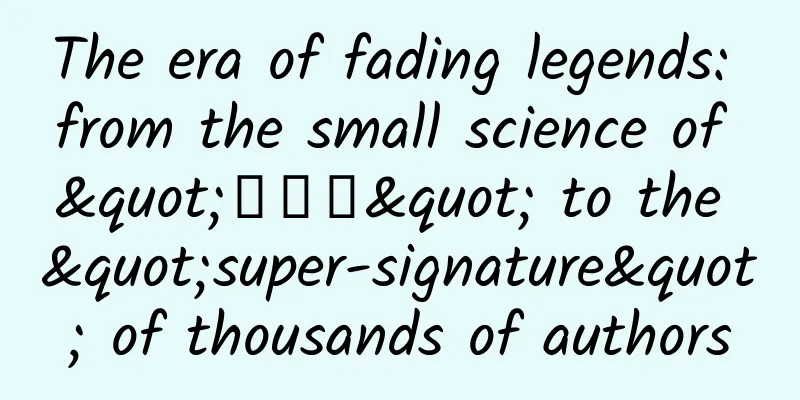The era of fading legends: from the small science of "αβγ" to the "super-signature" of thousands of authors

|
Written by | Qijun The organs removed during surgery were secretly made into biological products worth 3 billion US dollars by the hospital. Can the patients ask the hospital for compensation? This seems reasonable to many people, but the reality is not like this at all. In the United States, no matter how much the "flesh" that falls off your body is worth, you can't get a dime. It all started with a classic case in 1990. John Moore was an Alaska pipeline prospector who worked 12 hours a day, seven days a week. When he was about 30 years old, his gums were bleeding, his belly was swollen, and his body was full of bruises. John Moore丨Image source: See watermark After going to the hospital for a check-up, he learned that he had a type of cancer called hairy cell leukemia. Hairy cell leukemia is a rare malignant leukemia in which many defective white blood cells appear in the patient's body. Under a microscope, these white blood cells look like hair, hence the name. Mutated white blood cells (purple) of patients with hairy cell leukemia | Image source: wikipedia Normal white blood cells have the ability to fight infection and are a major part of the immune system, but these congenitally deficient white blood cells can undermine the body's immunity because they proliferate abnormally. The organ that was most seriously damaged in Moore's body was his spleen. One of the functions of the spleen is to store white blood cells. However, 20% of the white blood cells in Moore's blood were deformed and became furry. The "mutated" white blood cells occupied his spleen, causing his spleen to grow from 500 grams to 6 kilograms, a full 10 times larger. Spleen (purple on the right) | Image source: wikimedia Doctors were at a loss as to what to do with his disease. On October 5, 1976, Moore went to the UCLA Medical Center for the first time because he had heard of a famous leukemia oncologist named David W. Golde. David W. Golde | Image source: the lancet Golde believed that removing the spleen was the only way to treat Moore. Moore approved Golde's surgery and signed the hospital's preoperative consent form. This standard consent form stated that the hospital "may dispose of the removed tissue or limb by cremation." Moore signed without thinking too much because the surgery could not be performed without signing the consent form, and the operation went smoothly. Fortunately, within a few days after the operation, Moore's blood indicators began to return to normal and the symptoms of leukemia disappeared. If things had ended here, it would have been a happy ending. However, in the side story, Golde did not cremate the patient's spleen, but used it for various research. Because Golde discovered that the white blood cells extracted from Moore's spleen were quite unique. They produced large quantities of an anti-cancer drug: granulocyte-macrophage colony-stimulating factor (GM-CSF). Image source: pixnio This protein can be used to treat cancer patients who have lost white blood cells due to chemotherapy and radiation, and many pharmaceutical companies are interested in it. The active ingredient of Leucomax developed by Novartis at that time was this molecule. However, the production capacity of GM-CSF was relatively low at the time because a large amount of blood was needed to make the drug. If Moore's cells could be processed in batches, the cost of the drug would be reduced by more than half. Even more exciting was the discovery of a special virus in Moore's blood: human T-lymphotropic virus (HTLV). HTLV is a human retrovirus similar to the HIV virus that causes AIDS. But the strange thing about it is that it is different from all known animal retroviruses. HTLV virus (left) and HIV virus (right) | Image source: wikipedia The HTLV found in Moore was a new subtype, which was of great significance, so the researchers named the virus in his body HTLV-II. In addition, Moore's serum actually contained antibodies to the virus, which meant that his serum might be able to treat a T-cell malignancy caused by HTLV. Golde and his colleagues published this research result in Science in 1982. This research caused quite a stir and has been cited more than 1,480 times to date. Golde was also very excited about these findings. For further research, Golde suggested that Moore come for regular follow-up visits, and Moore agreed. Between 1976 and 1983, Moore, who lived in Seattle 1,500 kilometers away, repeatedly traveled between the two cities. In his opinion, this was a responsible and famous doctor's follow-up visit, but he didn't know that Dr. Golde also had his own little tricks. After a while, Moore began to feel troubled. He asked Golde if he could get tested in Seattle, where he worked. Golde offered to reimburse his round-trip airfare and provide him with accommodation in a luxury hotel. Image source: pxhere In 1983, seven years after surgery, Moore began to feel something was wrong. A nurse asked him to sign a consent form. The document stated that Moore voluntarily transferred the rights to his blood and bone marrow cell lines to the University of California. Moore signed it at first, but later regretted it. After returning to Seattle, Dr. Golde sent him two more emails urging him to sign. Moore felt something was wrong and consulted a lawyer. After investigation, the lawyer learned that in 1979, Golde successfully created a cell line derived from Moore cells - homologous cells that can replicate outside the human body. In honor of Moore, this cell line was named Mo. In January 1981, the University of California applied for a patent for the Mo cell line. In March 1984, the U.S. Patent and Trademark Office approved the patent for the Mo cell line. Image source: wikimedia In order to use this patent, pharmaceutical companies also came to Golde. Genetics Institute, a pharmaceutical company, gave Golde 75,000 shares (now worth $3 million) and paid him at least $330,000 in patent royalties. Later, another pharmaceutical company, Sandoz Pharmaceuticals, also paid $110,000 to use the Mo cell line. The two pharmaceutical companies also gave UCLA $3 million in research funding. Later, materials from the California Supreme Court showed that the Mo cell line was estimated to be worth $3.01 billion in 1990. This figure was considered a sky-high price in the 1990s. In other words, Golde and the University of California made a lot of money from the cells obtained from Moore, but Moore himself was not aware of it. This story may sound familiar to many people. The famous HeLa cell line was developed into the world's first immortal cell line without the knowledge of the cell owner, and then used in medical research and development around the world, involving countless interests and scientific and technological achievements. However, the owner of the HeLa cell line, African American Henrietta Lacks, and her family were unaware of this for a long time and did not gain any benefits. HeLa cell line and Henrietta Lacks | Image source: hms.harvard.edu Many people are indignant about this. But it should be pointed out that in the United States, natural human tissue cannot be patented. However, cells and tissues that have been modified by humans (such as cell lines) can be patented. Cultivating cell lines is not a simple process. Researchers have to find a very small number of cells that can survive in a culture dish and replicate themselves from the raw material, that is, the original human cells. This screening time is usually measured in years. The development time of the Mo cell line was 3 years. It can be said that without the work of a large number of highly educated biochemical elites, there would be no Mo cell lines, and a bunch of cell lines would not automatically pop out of Moore's spleen. On the other hand, without Moore's "donated" cells, there would be no Mo cell line. Greg Simon, chairman of the American patient advocacy organization FasterCures Pharmaceutical Lobby, pointed out that Moore's case is very special and his cells are very valuable. There are only 6-7 examples like him in the entire history of medicine. It is really hard to answer the question of who is more important, the good horse or the good horse. But from Moore's point of view, he was deceived. So in 1984, he filed a lawsuit against Golde, UCLA and related companies. Moore was the first person in U.S. history to claim ownership of one’s own tissue, and this was the first case in the country to examine the legality of using human tissue for commercial purposes. Science commented that this is an unprecedented case. Many researchers and drug research institutions are worried that if Moore wins the lawsuit, they will not have to do research and development in the future, because once there is any achievement, the owner of the cell will come to cause trouble. Image source: rawpixel But in 1986, the Los Angeles County Superior Court of California ruled that Moore did not own his cells, and the ruling was in favor of the University of California. Moore was dissatisfied and appealed to the higher court. In 1988, the California Court of Appeal overturned the previous ruling and supported Moore. This time, the University of California was unhappy. They continued to appeal and pushed the case to the California Supreme Court. In 1990, the California Supreme Court overturned the California Court of Appeals' ruling, ruling that the Mo cell line was not private property. The tide turned again on the University of California. The California Supreme Court ruled that Moore's cells were donated organs, and donated organs are not private property. In the United States, the law allows anyone to own property that others have given away, which means that garbage collection is legal and first come, first served. The California Supreme Court also said that medical progress would be impossible if researchers needed donors' consent to conduct research. It should be pointed out that the California Supreme Court also ruled that Golde did not obtain the patient's informed consent, which means that Golde did deceive Moore. Image source: pixabay Moore was dissatisfied and continued to appeal to the U.S. Supreme Court, but his appeal was rejected. In 1996, Moore's leukemia relapsed and he died in 2001. The Moore case caused a huge response. The U.S. Congress held hearings on the commercial use of human tissue. In 1995, former President Clinton also consulted with consultants on related matters. The Moore case became the basis for many subsequent cell line patent cases in the United States. After the Moore case, doctors and researchers could legally collect samples from patients for research without worrying that the patients would ask them for money later. Of course, many hospitals and research institutions also added corresponding clauses to the patient's informed consent form. Unlike the Moore case, the Mo cell line's halo gradually dimmed. In an interview with the New York Times, Golde said that after the lawsuit began, researchers across the United States immediately stopped using the Mo cell line. Until 1990, no drug research and development institution dared to use the Mo cell line for research, and anti-cancer drug research and development was out of the question. Later, another drug took over the market share of Leucomax, and the Mo cell line did not become a "cash cow" for pharmaceutical companies. Image source: wikimedia The Mo cell line is now stored in a liquid nitrogen freezer in Washington, and its genetic information is included in the CCLE cancer cell line and COSMIC genetic resource databases. Researchers can also order the Mo cell line on the official website of the American Type Culture Collection (ATCC), which costs about $664 (4220 yuan). The unit value of a small ball of "human flesh" has exceeded that of the "host", which is quite unreasonable for the donor. However, if there is no "magic output" from the researchers, they will probably just disappear into thin air together with the "host". Abnormal cells in ordinary people: Oh no, it’s over. Metamorphosis in the doctor's hands: making pills. References https://docs.qq.com/doc/DVFNoR1pjTVp1eFBq This article is authorized to be reproduced from the WeChat public account "Bring Science Home". Special Tips 1. Go to the "Featured Column" at the bottom of the menu of the "Fanpu" WeChat public account to read a series of popular science articles on different topics. 2. Fanpu provides a function to search articles by month. Follow the official account and reply with the four-digit year + month, such as "1903", to get the article index for March 2019, and so on. |
<<: How are diamonds cut? Do they cut themselves?
>>: The key points of epidemic food reserve: the most complete and condensed version ever
Recommend
Super hardcore! The great power weapon has a new one
Recently, good news came from the space environme...
Tumor "natural killer"! New progress in NK cell research at USTC
Natural Killer (NK) cells are important members o...
400 activation and charging standards, how much does it cost to activate a 400 phone number?
400 telephone numbers are not completely free num...
60,000 apps removed from shelves in two days! How should CP respond to Apple’s App Store cleanup?
The editor has observed that the App Store has be...
Experts discuss: The future development path of Chinese brands
Innovation drives the rise of independent brands ...
Microsoft foldable Bluetooth keyboard review: 5mm ultra-thin and feels good
Microsoft is very experienced in manufacturing PC...
Analysis of the classic popular articles on Xiaohongshu in 2021
In the brand promotion of Xiaohongshu , a hot art...
3 strategies for native advertising!
Only by using fewer "tricks" can you tr...
100 marketing campaigns, 20 campaign experiences!
Every year, I participate in the planning and imp...
What exactly is the problem with Meizu phones?
Before, I could never understand why a company th...
Was chocolate originally a drink? And you had to add chili to it!!
Do you remember the feeling of eating chocolate f...
BRAF mutation! What happened to the little switch in the body? New breakthrough in lung cancer treatment →
Dear readers, hello! Today, we are going to talk ...
iPhones shut down due to freezing? Apple responds: It's too cold
This cold wave was so severe that it affected eve...
Apple or Google, who will be the winner in mobile payment in the future?
June 8th news, according to foreign media reports...
Southerners: Why do we need to scrub our bodies? Northerners: It can remove dead skin cells!
Tell me quietly, are you from the north or the so...









